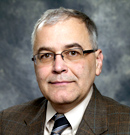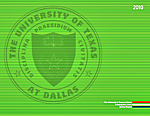A mid-school year report card shows UT Dallas making progress or ahead of schedule in reaching several key goals in its strategic plan.
Leading the list are gains in research activity and enrollment, but the progress touches virtually every aspect of academic life.
- Yearly research activity has nearly doubled, hitting a record-breaking $82 million.
- Enrollment hit a new high of 17,128.
- The University had conferred more doctoral degrees – 202 – than in any previous year.
- Total tenure-track faculty rose to 446, on track with the University’s strategic plan.
- Total private fundraising set a record.
2010 Annual Report
“This report is a reflection of perhaps the best year in UT Dallas’ history — a year in which we set records for just about everything.” Read More
“UT Dallas is meeting or exceeding nearly all major goals,” said President David E. Daniel. “Our performance and momentum have never been stronger.”
The fact that the University made these gains against a backdrop of decreased state funding for higher education makes them all the more impressive, the president said. “UT Dallas may be among the best-positioned universities in America to ride out the difficult times.”
Research/Faculty
The $82 million research figure is regarded as a significant milestone on the University’s drive toward becoming a Tier One research institution.
“Research expenditures is one benchmark for gauging research universities,” said Dr. Bruce Gnade, UT Dallas vice president for research. “Generally, $100 million is considered the entry point for consideration as a strong research university. The most recent numbers show that we are closing the gap quickly.”

Dr. Bruce Gnade
The jump – a 25 percent increase over last year – was partially due to an increase in research dollars received from Federal sources such as the National Science Foundation, the Department of Energy and the National Institutes of Health. These competitive grant awards fund a wide array of research into topics including nanotechnology, language development and research into degenerative brain diseases, among others.
Research funding increases can set into motion a virtuous cycle in which the gains multiply themselves, administrators say. The hiring of prominent research faculty brings in increased research funding, which in turn makes the University appealing to other top researchers. The cycle repeats, and the funding grows.
“In the last three years, we have hired many great faculty who left top research universities to come to UT Dallas,” Gnade said. “When you attract outstanding faculty like these, other faculty want to come to the institution because we are building a reputation for doing great research.”
UT Dallas has hired more than 194 tenured and tenure-track faculty since 2005. The University currently has 446 faculty. The strategic plan calls for that number to climb to 610 by fall 2017.
These increasingly strong faculty resources factored highly in U.S. News & World Report ratings, which for the first time this fall ranked UT Dallas in the first tier at No. 143 nationally, tying Arizona State, Rutgers and the University of Illinois at Chicago, among others. The University was 72nd among all public universities in its category and third among Texas public universities.
High-Achieving Student Body Grows
The University has experienced one of the largest enrollment growth spurts in its history. The student body numbered 17,128 at the end of the fall semester, an increase of 8.5 percent from the previous year and 18 percent since 2005.
An imperative of the University’s strategic plan is to expand UT Dallas by 5,000 students, to about 22,000, by 2017. High-achieving students have accounted for the gains thus far.
For fall 2010 enrollment, the average SAT score for incoming freshmen, 1245, remains among the highest of any university in Texas. Nearly 40 percent of incoming freshmen graduated in the top 10 percent of their high school classes, and almost 75 percent were from the top 25 percent.
The retention rate for freshmen — those who returned from fall 2009 — is 85 percent, up 2 percent from last year.
The new students are finding new academic programs when they get to UT Dallas. The University has added 33 new degree offerings since 2005. The increase represents a growth of 30 percent in degrees offered. Almost half — 15 of the new degree plans — are in high-demand science, technology, engineering and math disciplines, and 21 of the new options are offered at the master’s and doctoral level.
“UT Dallas offers opportunities to all students, ranging from lab research to field work,” said Dr. Sheila Amin Gutiérrez de Piñeres, dean of undergraduate education at the University. “This University is a steppingstone to a future that students themselves define and pursue. We will continue to grow both in quality and quantity as our reputation grows.”
